Urchinomics aims to preserve sea plants and boost rural communities while tapping into a lucrative market
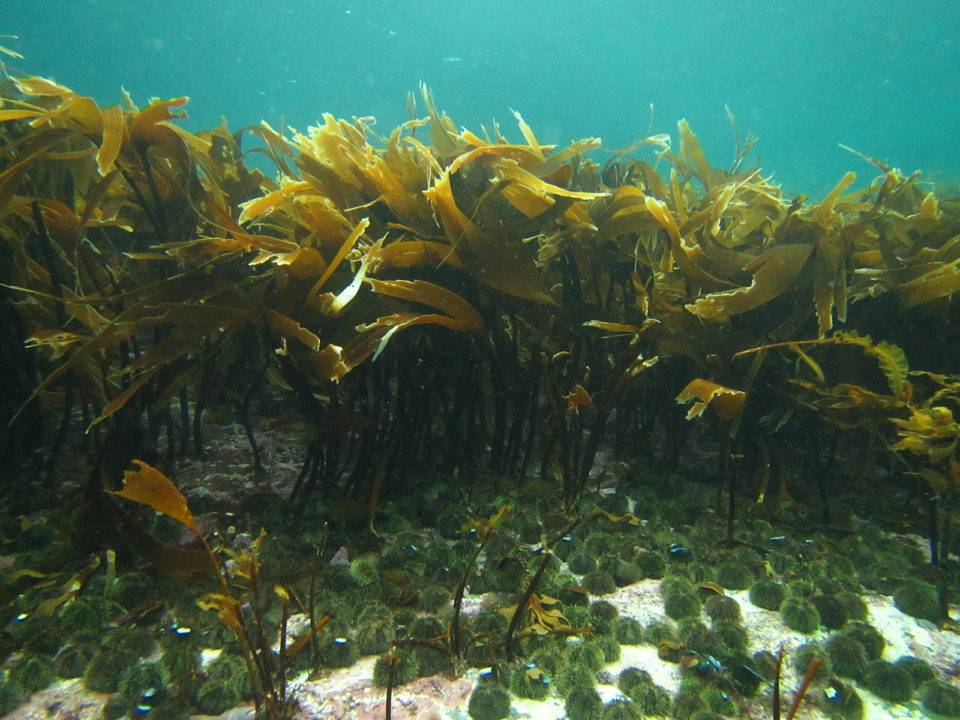
Kelp forests are faithful ecological servants. These dense thickets of marine plants provide fish habitat, dissipate waves, sequester carbon and prevent coastal erosion. For these life-proliferating gifts they ask for nothing in return except clean water and a little sunshine.
And, if possible, some protection from herds of zombie urchins – thousands of hungry purple pin cushions inching along on the sea floor hell-bent on total vegetative destruction.
Call them The Crawling Dead, these ravenous sea urchins that once mindlessly munched on the lush, green macroalgae species kelp (Laminaria hyperborean) and giant kelp (Macrocystis pyrifera), among others. Left unabated, urchins can quickly convert acres of sea floor into virtual deserts, leaving barrens in their wake.
But after overgrazing in a given area, eventually the spiny squatters are deprived of the nutrients necessary to develop healthy, edible gonads and they end up existing as mere shells of their former selves. On sushi menus, the bright-orange lobes of flesh from healthy urchins are expensive delicacies, particularly in Japanese cuisine in which they are called uni. Without them, or from eating whatever ocean detritus is available in the absence of kelp, the starving, undead urchins are virtually without value. Specimen harvested from barrens typically have little to no gonads to offer, and what’s left is unpalatable.
We’re trying to clean up the ocean from our … questionable behavior.
Until recently, a leading solution to cleaning up urchin barrens has been to relocate and sequester select individuals, while smashing to bits the hollowed shells of more than 90 percent of the others – and then hoping that the uni and the kelp forests can regrow. Such efforts have indeed seen some success in places like Southern California. The Bay Foundation in Los Angeles, which conducts restoration efforts in about 150 acres of urchin barrens along rocky reefs off Palos Verdes, Calif., says that while barrens can be relatively short-lived events, others can last for decades. And the scarcity of known urchin predators like sea otters – as is the case in California – exacerbates the problem.
Urchin barrens have been documented worldwide, and are particularly acute off the coast of Norway, where they’ve long been studied. Now, thanks in part to research and feed technologies commenced by the country’s massive salmon-farming industry, commercial development of ranch-raised urchins is under way.
Brian Tsuyoshi Takeda – a Japan-born, Canada-raised entrepreneur who now resides in Norway, where urchins have wiped out massive swathes of kelp forests – has a much better idea than simply putting the hammer to these spiny invaders. Takeda told the Advocate that his venture, Urchinomics, can ranch zombie urchins, fatten them up on an innovative feed that his team is developing in partnership with a well-known international conglomerate, and then – hopefully just weeks later – sell a replenished, farm-fattened uni product to eager buyers.
By restoring otherwise worthless urchins to usefulness, and preventing their underwater advances, Takeda’s pioneering business model would serve a number of purposes.
“It’s a way to use capitalism, science, technology and cutting-edge aquaculture practices to restore coastal fisheries and create sustainable jobs in rural communities, so that fishers don’t have to go out and take, take, take,” Takeda said. “We think we have the potential to build the model that is a win-win for everyone. That’s what we’re trying to prove.”
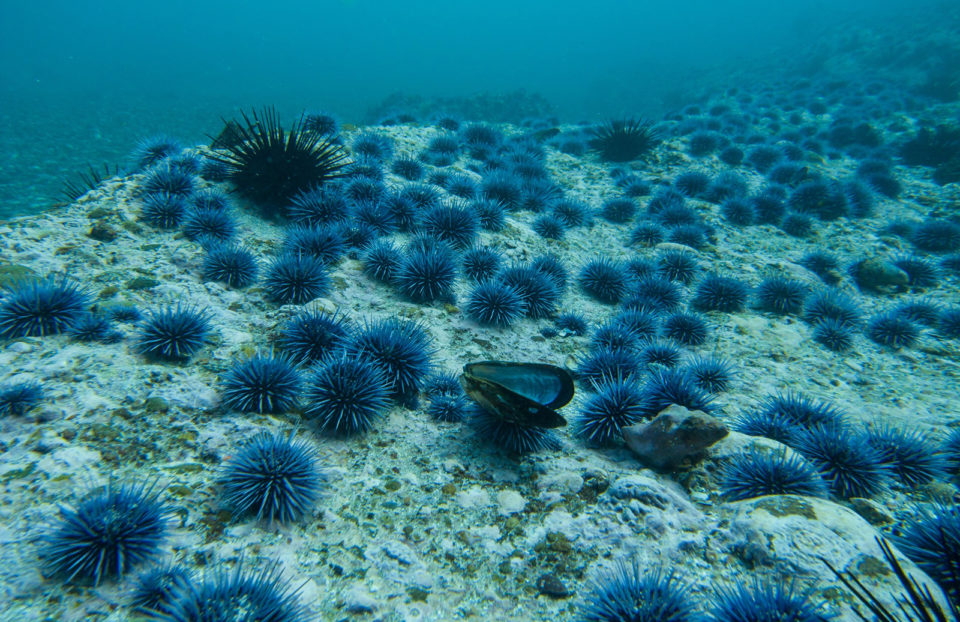
Factors in the formation of urchin barrens
The decline of a key predatory species, particularly through human interference like hunting or fishing activity, can have cascading impacts on ecosystems. Dwindling numbers of sea otters off the coast of California helped fuel explosive growth in urchin populations, which led to massive kelp forest losses. The U.S. Geological Survey reported in late 2017 that only 3,186 sea otters remained in the state, a 3 percent decline from the previous year. Not only do urchins wipe out kelp and other forms of algae, they outcompete other species for food, such as abalone.
Renee Angwin, laboratory manager at the San Diego State University Coastal and Marine Institute Laboratory, said urchins seize upon any opportunity, or “variation in the ecosystem” to proliferate – and surprisingly quickly. Despite their sedentary appearance, urchins can really cover some ground.
“Like sea stars, they are echinoderms, with a hydrostatic skeleton that’s essentially hundreds of tiny feet across the substrate. They can consume a couple of feet of kelp a day, a good amount in a short time,” said Angwin, adding that urchins held in captivity without any food to eat can eat through fiberglass tanks they’re being held in.
When urchin barrens establish and persist, the biodiversity essentially goes from 700 species to 1, explained Takeda.
“When kelp forests recover, the first things that come back are the little creatures that live on the kelp and eat urchin larvae and prevent the cycle from spinning out of control again,” he said.
Warm water from El Niño events also make for kelp difficult conditions, added Angwin, giving urchins yet another window of opportunity to grow. In February, she said she was about to commence feeding trials to determine whether the feed technologies that Urchinomics has developed for urchin species in Norway are compatible with those found in California. She’s optimistic that Urchinomics can make an impact.
“On the ecology side, it’s a huge benefit. There’s nothing but positives” thus far, she said. “Smashing them up can help restore kelp, but it creates a big waste problem. As long as the urchins eat the feed, it’s feasible. It’s possible that in six to 12 weeks, zombie urchins can produce enormous gonads you can sell on the market.”
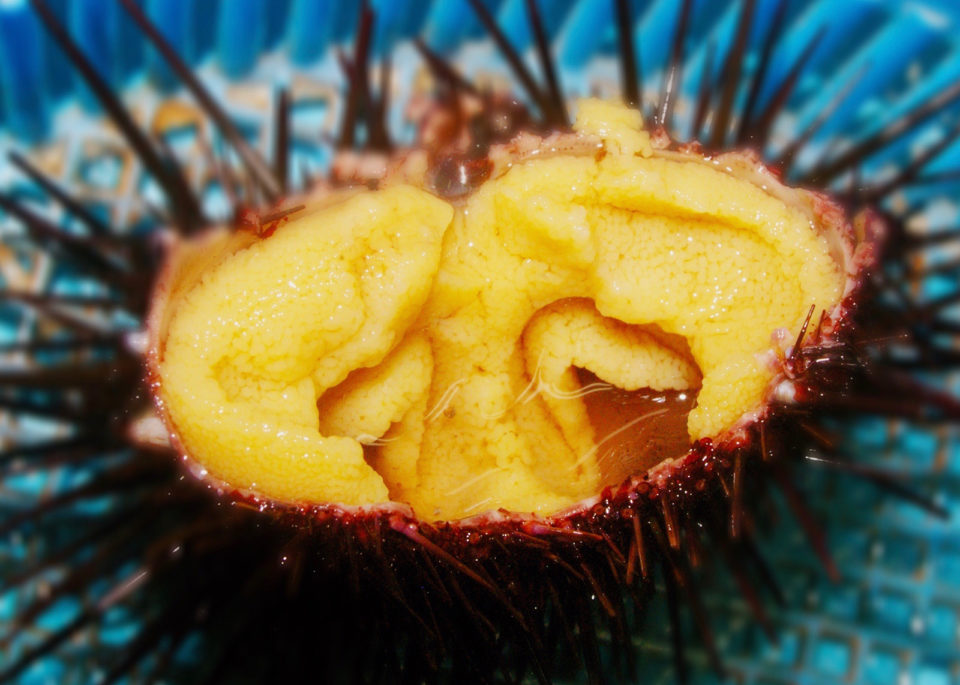
The Urchinomics solution
Takeda is hopeful that Angwin’s results will validate his belief that not only is the feed going to work, but that the wider social impacts of his business model are also within reach.
“I originally thought we’d be limited to existing commercial [urchin] species, like the main greens in the east of North America, the reds of western North America and the Japanese,” he said. “There’s research suggesting that urchin roe flavor and color is heavily determined by what it’s eating. I’m cautiously optimistic that the feed technology will work on other species that historically we might not have thought about.”
Takeda, who moved to Norway in 2012 to join a small private equity firm with a sustainable and responsible investment bent, explained that the “genesis” of Urchinomics dates back to salmon-farming research that began in Norway in the 1970s. The feed technology at the core of Urchinomics’ model was developed by the national research institute NOFIMA in the 1990s.
The original formulation, Takeda explained, was primarily plant based with a small amount of fishmeal in it and no hormones, antibiotics or other “controversial ingredients one can find in aquaculture and agriculture feeds today,” he said. Further studies has led to the development of a plant-based feed containing zero fishmeal, which is now undergoing performance tests, both at UCSD and in Japan.
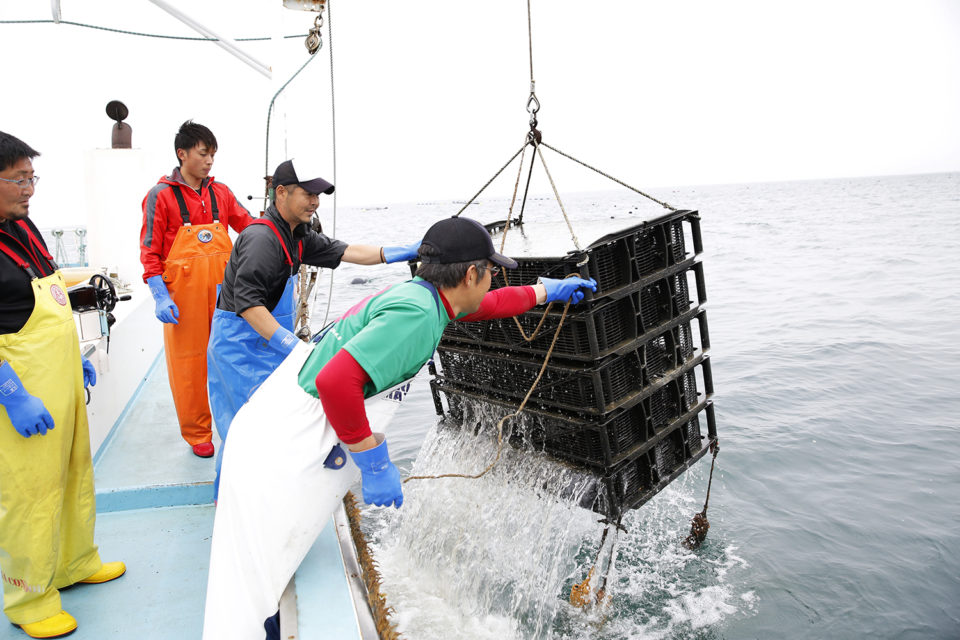
The newest Urchinomics feed blends come in extruded-pellet form, much like those for finfish like salmon, but its advantage is water stability: It doesn’t break apart and dissolve for seven to 14 days.
“It’s essentially designed to match slow-eating benthic creatures, as opposed to fish that just swallow it whole,” said Takeda.
Urchinomics holds the global rights to the feed, which is being produced by Mitsubishi Corporation which licensed the technology from Urchinomics in order to produce at industrial scale. The partnership comes with a huge advantage, which is Mitsubishi’s access to high-quality offcuts of kombu and wakame, types of human food-grade seaweed that Takeda said are difficult to secure. Because of the high quality ingredients, he’s optimistic that current feeding trials, utilizing these newest blends, will outpace previous results. Soon they could have a sellable product – as early as this year if they wanted to – as the urchins show an uncanny knack for quick recovery if given proper nutrition.
“Right now we are making adjustments for local species. The core technology is there. Each urchin species, or even each individual urchin, depending on region and particular ecosystem, will have different flavors,” said Takeda. The end goal, however, is simple, he concluded: “It has to grow roe and taste good.”
Takeda insists that only urchins from a local population would be selected for ranching, or grow-out in a sea-cage system that’s not unlike what is commonly used for bivalve shellfish like oysters. No urchins would be transported, to allay concerns about invasive species, and farms would be set up on the very barrens where the urchins have caused so much destruction. Takeda says the “rehoming” process will thin out urchin populations on the benthic floor and give the kelp a chance to rebound.
Kelp forests are the oceans’ equivalent of rain forests, Takeda added, but their deforestation had gone largely unnoticed because it’s all happening beneath the surface.
“We can’t stop overfishing. We can at least mitigate or restore the negative consequences that come with climate change, overfishing of predatory species and pollution,” he said. “We’re trying to clean up the ocean from our … questionable behavior.”
Follow the Advocate on Twitter @GAA_Advocate
Author
-

James Wright
Editorial Manager
Global Aquaculture Alliance
Portsmouth, NH, USA
[103,114,111,46,101,99,110,97,105,108,108,97,101,114,117,116,108,117,99,97,117,113,97,64,116,104,103,105,114,119,46,115,101,109,97,106]
Tagged With
Related Posts

Innovation & Investment
Artemia, the ‘magic powder’ fueling a multi-billion-dollar industry
Artemia, microscopic brine shrimp used as feed in hatcheries, are the unsung heroes of aquaculture. Experts say artemia is still inspiring innovation more than 50 years after initial commercialization. These creatures are much more than Sea-Monkeys.
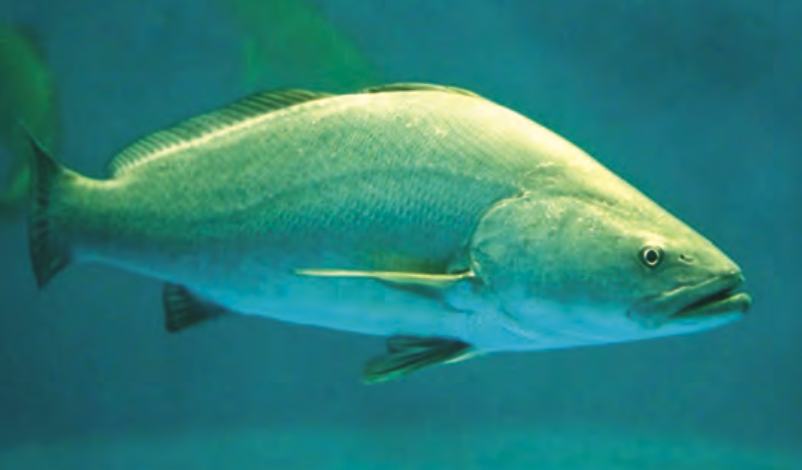
Responsibility
Aquaculture gives endangered totoaba a fighting chance
The tenuous fate of a pint-sized porpoise, the critically endangered vaquita, is linked to a fish targeted by poachers fueling China’s appetite for maws. The vaquita remains in peril, but aquaculture presents some hope for the totoaba.
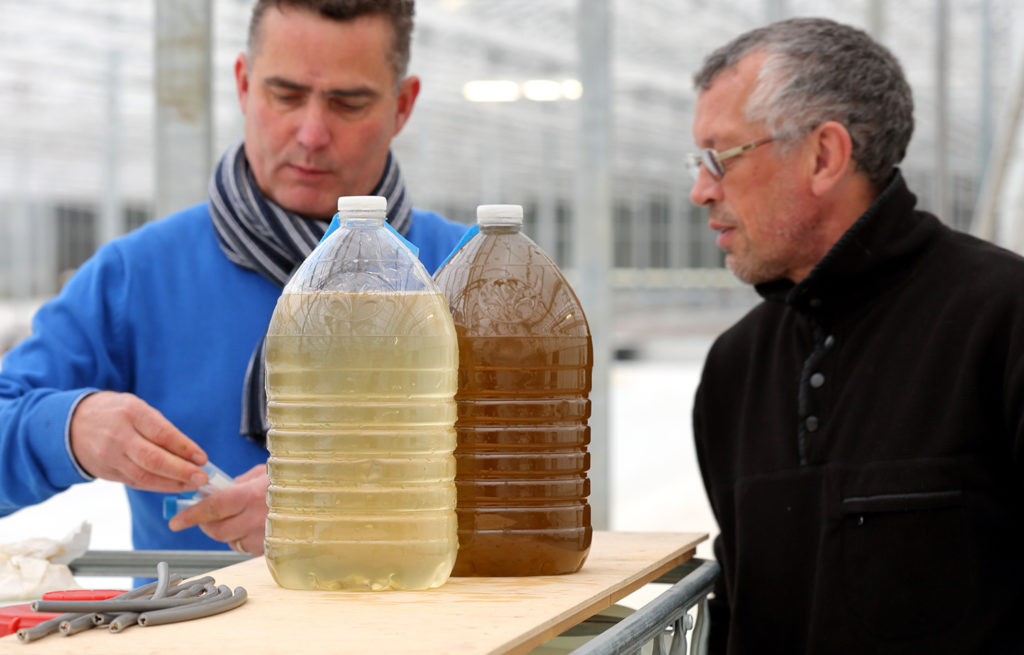
Innovation & Investment
Algae innovators aim to freeze out early-stage shrimp losses
A greenhouse in Belgium believes its innovative shrimp feed product, made from freeze-dried microalgae, packs the necessary nutrients for the crustacean’s most vulnerable life stage: the first three days of its life.

Aquafeeds
A new nutrient for aquaculture, from microbes that consume carbon waste
Biotechnology firm NovoNutrients aims to produce a line of nutraceutical aquafeed additives as well as a bulk feed ingredient that can supplement fishmeal. Its process includes feeding carbon dioxide from industrial gas to a “microbial consortium” starring hydrogen-oxidizing bacteria.

